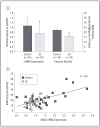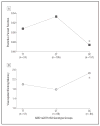Downregulated kynurenine 3-monooxygenase gene expression and enzyme activity in schizophrenia and genetic association with schizophrenia endophenotypes
- PMID: 21727251
- PMCID: PMC3855543
- DOI: 10.1001/archgenpsychiatry.2011.71
Downregulated kynurenine 3-monooxygenase gene expression and enzyme activity in schizophrenia and genetic association with schizophrenia endophenotypes
Abstract
Context: Kynurenic acid, a metabolite of the kynurenine pathway of tryptophan degradation, is an antagonist at N-methyl-d-aspartate and α7 nicotinic acetylcholine receptors and modulates glutamate, dopamine, and acetylcholine signaling. Cortical kynurenic acid concentrations are elevated in the brain and cerebrospinal fluid of schizophrenia patients. The proximal cause may be an impairment of kynurenine 3-monooxygenase (KMO), a rate-limiting enzyme at the branching point of the kynurenine pathway.
Objectives: To examine KMO messenger RNA expression and KMO enzyme activity in postmortem tissue from the frontal eye field (FEF; Brodmann area 6) obtained from schizophrenia individuals compared with healthy control individuals and to explore the relationship between KMO single-nucleotide polymorphisms and schizophrenia oculomotor endophenotypes.
Design: Case-control postmortem and clinical study.
Setting: Maryland Brain Collection, outpatient clinics.
Participants: Postmortem specimens from schizophrenia patients (n = 32) and control donors (n = 32) and a clinical sample of schizophrenia patients (n = 248) and healthy controls (n = 228).
Main outcome measures: Comparison of quantitative KMO messenger RNA expression and KMO enzyme activity in postmortem FEF tissue between schizophrenia patients and controls and association of KMO single-nucleotide polymorphisms with messenger RNA expression in postmortem FEF and schizophrenia and oculomotor endophenotypes (ie, smooth pursuit eye movements and oculomotor delayed response).
Results: In postmortem tissue, we found a significant and correlated reduction in KMO gene expression and KMO enzyme activity in the FEF in schizophrenia patients. In the clinical sample, KMO rs2275163 was not associated with a diagnosis of schizophrenia but showed modest effects on predictive pursuit and visuospatial working memory endophenotypes.
Conclusion: Our results provide converging lines of evidence implicating reduced KMO activity in the etiopathophysiology of schizophrenia and related neurocognitive deficits.
Figures




References
-
- Schwarcz R, Rassoulpour A, Wu H-Q, Medoff D, Tamminga CA, Roberts RC. Increased cortical kynurenate content in schizophrenia. Biol Psychiatry. 2001;50(7):521–530. - PubMed
-
- Erhardt S, Schwieler L, Nilsson L, Linderholm K, Engberg G. The kynurenic acid hypothesis of schizophrenia. Physiol Behav. 2007;92(1-2):203–209. - PubMed
-
- Müller N, Schwarz M. Schizophrenia as an inflammation-mediated dysbalance of glutamatergic neurotransmission. Neurotox Res. 2006;10(2):131–148. - PubMed
-
- Miller CL, Llenos IC, Cwik M, Walkup J, Weis S. Alterations in kynurenine precursor and product levels in schizophrenia and bipolar disorder. Neurochem Int. 2008;52(6):1297–1303. - PubMed
Publication types
MeSH terms
Substances
Grants and funding
- M01RR16500/RR/NCRR NIH HHS/United States
- K12 RR023250/RR/NCRR NIH HHS/United States
- R01 MH067014/MH/NIMH NIH HHS/United States
- MH67014/MH/NIMH NIH HHS/United States
- MH079172/MH/NIMH NIH HHS/United States
- M01 RR016500/RR/NCRR NIH HHS/United States
- R01 MH049826/MH/NIMH NIH HHS/United States
- MH68580/MH/NIMH NIH HHS/United States
- MH075101/MH/NIMH NIH HHS/United States
- MH-K12RR023250/MH/NIMH NIH HHS/United States
- R01 DA027680/DA/NIDA NIH HHS/United States
- P30 MH068580/MH/NIMH NIH HHS/United States
- R03 MH075101/MH/NIMH NIH HHS/United States
- R21 MH079172/MH/NIMH NIH HHS/United States
- R01 MH085646/MH/NIMH NIH HHS/United States
- MH49826/MH/NIMH NIH HHS/United States
LinkOut - more resources
Full Text Sources
Other Literature Sources
Medical

